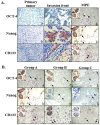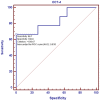Pulmonary Adenocarcinoma in Malignant Pleural Effusion Enriches Cancer Stem Cell Properties during Metastatic Cascade
- PMID: 23658677
- PMCID: PMC3641054
- DOI: 10.1371/journal.pone.0054659
Pulmonary Adenocarcinoma in Malignant Pleural Effusion Enriches Cancer Stem Cell Properties during Metastatic Cascade
Abstract
Background: Metastasis occurs in a series of discrete steps involving invasion, angiogenesis, lymphovascular space permeation, and establishment of secondary tumors. Malignant pleural effusion (MPE), a type of tumor metastasis, is usually a poor prognostic sign for patients with pulmonary adenocarcinoma, although its underlying mechanism has received less attention than other types of metastases have. The objective of the current study was to confirm whether cancer stem cells (CSCs) in MPE contribute to the "metastatic cascade" through the epithelial - mesenchymal transition (EMT), anoikis, and adaptation in the microenvironment.
Methods: Pulmonary tissue and corresponding cell blocks of MPE samples from 20 patients with primary adenocarcinoma were analyzed by immunohistochemical staining with CSC-representative markers (CD133, Nanog, and OCT-4) and EMT-associated markers (E-cadherin and vimentin). Correlations between these variables and clinico-pathological parameters were analyzed. Primary cultures from eight cases of MPE were investigated to characterize the CSC properties, including marker expression, sphere formation, and differentiation.
Results: Expressions of CSC-representative markers for 20 cases of MPE cell blocks were quite diverse and variable ranging from 15% to 90%. Stronger expression of CSC-representative markers and alteration of EMT-associated markers were found at the invasive fronts and in MPEs compared with the expression in primary pulmonary tumor tissues. The expression of OCT-4 in MPEs significantly related to distant metastasis and stage, as well as inversely correlated with patient survival. Primary cultures confirmed the CSC properties in MPE. Five of eight cases of MPE yielded adequate cell clusters, which also showed variable expressions of CSC markers in addition to sphere formation and the ability for differentiation and metastasis.
Conclusion: This pilot study offers a better understanding of the metastatic cascade. Establishing a model of MPE will provide further insight into the role of CSCs in metastasis and may explain the high therapeutic failure rates for patients with MPE.
Conflict of interest statement
Figures






References
-
- Li F, Tiede B, Massague J, Kang Y (2007) Beyond tumorigenesis: cancer stem cells in metastasis. Cell Res 17: 3–14. - PubMed
-
- Antic T, Gong Y, Sneige N (2012) Tumor type and single-cell/mesothelial-like cell pattern of breast carcinoma metastases in pleural and peritoneal effusions. Diagn Cytopathol 40: 311–315. - PubMed
-
- Edge SB, Compton CC (2010) The American Joint Committee on Cancer: the 7th edition of the AJCC cancer staging manual and the future of TNM. Ann Surg Oncol 17: 1471–1474. - PubMed
-
- Liotta LA, Kohn E (2004) Anoikis: cancer and the homeless cell. Nature 430: 973–974. - PubMed
Publication types
MeSH terms
Substances
LinkOut - more resources
Full Text Sources
Other Literature Sources
Medical
Research Materials

